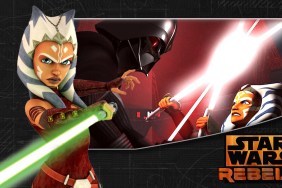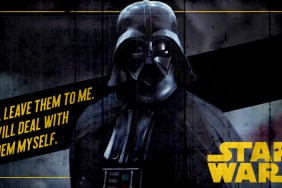On the comic and the Repo phenomenon

There’s a handful of unique artists out there that are not only distinguishable through their art, but that are also able to create a whole world for their original characters to fully flourish in. One such artist is Terrance Zdunich.
Having co-created and written the cult phenomenon Repo! The Genetic Opera, not to mention star in the film as the ominous Graverobber, his latest project is an ambitious self-published 12 issue graphic novel titled The Molting. And while both Repo and The Molting don’t fall completely in the horror genre, they do flirt with enough dark content to appeal to genre fans, and more importantly Shock readers.
Shock Till You Drop had the opportunity to sit down and candidly chat with Terrance about the origins of The Molting, the overall story arc for the book and the Repo phenomenon and how it’s influenced his current work.
Robg.: Obviously, you come from a pretty strong art background, so a comic book/graphic novel almost seems like a no brainer. What was the genesis for this story for The Molting? Did you always plan it to be this long 12 issue arc?
Terrance Zdunich: I donât know if I knew immediately if it was going to be specifically 12 issues, but the germ of the idea was â I grew up in San Anna, California, and it was a neighboring city of Anaheim. Even when I was a kid looking at Disneyland, I always found something creepy about it. And what particularly struck me and this is the setting of the main story which really takes off with the second issue, was that Anaheim was a shitty, slummy neighborhood⦠and right in the middle of it was this magical kingdom touted as âthe happiest place on Earthâ. So that kind of paradox was ultimately what inspired the story for The Molting. In terms of why a graphic novel? Why 12 parts? Just the very title, with molting and changing and growing and shedding and building new armor, I just felt like it needed to be something that felt big. It needed to feel like it was continually changing. Youâll see even when we get to the second issue, the style of the drawings and the way the characters look changes from issue to issue. By the time we get to issue 12, it all makes sense and hopefully youâll think âwow, that was a piece. That was a comic opera!â [Laughs]
Robg.: In issue one, we meet and focus on Susie. So is each issue going to focus on one particular character and their story? Or is there a through line in this whole story?

Terrance: There is. And Susie is a main character. Itâll shift focus a bit. The first issue, appropriately named Guilty Susie in the context of the whole story acts as a prologue. Literally the next issue, we jump forward just shy of 30 years and Susie has a family now. And two kids. Youâll start to see how elements of the past are starting to affect the present. Then weâll jump way back, but there is a connection between all the characters. Susieâs actions in the first issue definitely set the playing field for everything else that happens in the story.
Robg.: What I love about this and even something like Repo! The Genetic Opera is the characters are so in-depth. It feels like there was a lot of thought put into each one and into creating this whole world for them. You look at Repo and that is its own world with all these charactersâ¦
Terrance: And maybe thatâs too complicated. [Laughs]
Robg.: No! But whatâs interesting is with everything youâve worked on, you always create your own world for it. So how do you go about that process? Do you create the characters first and then their backstories and figure out how they connect? Or do you have the whole story thought out first and create characters to be a part of it?
Terrance: Yeah, I think it moves around a bit. Sometimes answering that honestly is a bit of a chore, and not because I donât want to answer that honestly! But because the creative process takes you in so many different places that you almost donât remember. People ask me âwhat was the original creative spark for Repo?â And I think âI donât know! I canât even remember!â I know it was something. Since this is a little fresher in my mind whereas Repo is 10 years old, I think because I have a visual arts background, I tend to think visually. And as such, the settings are very much a character. If you look at Repo, that world is really the main character. You could say itâs the Shilo story, but really itâs an ensemble piece. Itâs about the world of Repo, the world of Genco. I think the world of The Molting, especially the way you see how I handle Anaheim and Disneyland in the second issue â I may be sued for it! I definitely liked the idea of creating it as its own character. What I really like about The Molting and whatâs very different about that and the characters and the way Iâm approaching it as opposed to Repo, Repo because of the music I really got into the idea that each character should have their own musical motifs. Theyâre own style and their own aesthetic sonically. Now with The Molting because its pictures and imagery, how you really handle the text, the way their speech and word balloons look? Thatâs part of their character. So you can always identify that as the character, even if theyâre not in the frame. Thatâs really fascinating to me and to do it in such a short hand fashion, I mean with comics you cut out all the fat. If itâs novelesque, then youâre probably writing in the wrong medium. In comics itâs like how do you distill the essence in a few words, in a few balloons? I wrote out The Molting almost like a screenplay. It was a 120 some odd pages of text, which is completed and thatâs the entire 12 issue story arc, although in comic form itâll be about 450 pages. But I remember going through and just cutting away anything that didnât work. In the first chapter, which is very brief, you lose almost all the characters youâre introduced to by page 20, and itâs not a lot of time to give you an essence, but I think you do. I asked people and theyâre a little jarred and feel lost that these characters are gone by issue one. They wanted to know more about the aunt and uncle. They thought the brother was going to come in and save the day, and then theyâre lost. And thatâs the point because Susieâs lost. Everything in a moment was taken and you think what happens next? That was very intentional.
Robg.: Itâs funny you mention using the word balloons to identify characters. Alan Moore would do stuff like that on Watchmen. The way Rorschachâs word bubbles looked were always different from the other character, to match what his voice might sound likeâ¦

Terrance: With Susie and you probably wonât notice this yet, Iâm working with Oceano Ransford whoâs the letterer on the project, and we talked about the idea that in this issue, sheâs just a kid so her lettering should look girlie. And then when things go bad, it remains girlie and childlike, but it corrupts somehow. So we go from pink lettering to this grayish color and still childlike. Sheâs still going to talk that way as an adult. I just think to me, thatâs creepy! A crazy woman with two kids still talking like a little girl! To me itâs like how do you visually show that? So those challenges excited me.
Robg.: What are some of your personal visual and story influences?
Terrance: I draw from a lot of things. Ironically even though I always drew and I always liked illustration, I wasnât really into comics as a kid, so itâs an art form that in the last five years Iâve really gotten into and Iâm really blown away by it. You mentioned Alan Moore or even Neil Gaimanâs work on Sandman; itâs really some of the best work and writing around. Opposed to movies, which I do love, itâs more of a singular vision in comics. While there is a collaboration, itâs not a multi-million dollar collaboration with thousands of hands like for a movie. Itâs usually just a couple of people.
Robg.: Hell, your comic is three people!
Terrance: Yeah, three people that put this together and will continue to put it together and I really like that aspect. Recently, I love Alan Mooreâs stuff, From Hell is an excellent story. Any of the Sandman books are great modern mythology. What I got from those authors is just how far you can go with the medium. From Hell for example, when I first saw the art, I initially thought egh, because I was so used to comic book art with such detail and force perspective and superheroes, and The Molting will give you that as it goes along, but From Hell and other works by Moore are all about the story. And when you get into them, you realize the drawings are intentionally not flashy. Theyâre intentionally suiting the story. So, what we did with the first issue here, I chose to do something very childlike. Itâs the story of a little girl, almost like a fairy tale where the judge who exists almost as a voice over is the narrator. The âonce upon a timeâ, heâs the voice of God, the voice of legend. And so we chose to make the first letters the big block letters, the way youâd see in a manuscript or something. But then all these horrible things start happening. The drawings remain innocent, almost simple. But itâs really that the voice of God, the voice of this judge has no idea whatâs best for these kids. Heâs pronouncing these judgments and sending this little girl to her doom! And unknowingly sending this next few generation of children to their doom.
Robg.: So⦠what do you have against Disneyland? [Laughs] I mean, have you been there? Because it really is the happiest place on earth!
Terrance: [Laughs] Well, actually I like Disneyland! So itâs not that at all. In fact, I love Disney movies! I miss 2D animation. I wish someone would do it well again and bring it back. I think itâs more of a social commentary within this story more then anything. Because I remember seeing the neighborhoods back then in Anaheim in particular and you see these households, largely Hispanic households where theyâd be overcrowded and jammed in, people who probably couldnât even afford to get into the theme park, and yet how belittling to look at these signs leading to âthe happiest place on Earthâ. The reality is how do you ignore that? Itâs like the poppers are just beyond the fence of royalty. Although, the Disneyland portion of the story takes place in the 90âs and Iâve since seen it improve. It seems that Disneyland has solved that problem by literally buying all of Anaheim! [Laughs] So I donât think any of those slums exist anymore. First marginalized, then literally bought out.
Robg.: We have to touch upon the Repo! The Genetic Opera phenomenon a bit. Youâre going for a comic book audience with The Molting, but youâve also developed this big following through Repo. So what have you learned from your experiences on the road with Repo, in terms of your interaction with fans? Did it influence how you approached this book knowing you had people anticipating it?
Terrance: Um, I donât think it influenced the creation of the book, but it most certainly influenced how I went about producing it. It gave me the courage to do it on my own, because first off, itâs an amazing amount of work to create anything, let alone a comic, which is lots of workâ¦
Robg.: Was self distribution always the plan for The Molting?

Terrance: It wasnât. I think initially I would have done what any one would have done â Thereâs this notion that you need to create something and sell it. Itâs funny, when I mentioned the comic to people, the first thing theyâd ask is âwhatâs it about?â or âwhoâs publishing it?â Which in essence is, âwho did you sell away your idea to?â [Laughs] And not that thereâs anything wrong with that in principle. Iâd love to be in every Barnes & Nobles and Borders, but I think because of the fanfare and the positive reaction of Repo, and going on the road and interacting directly with the audience, which will hopefully be The Moltingâs audience, it gave me the courage to go why do I even need to do that, at least initially? Literally Iâm communicating directly with the people that are going to buy it anyways. Iâd rather do it on my own, make it a singular piece of art, not influenced by how to make money or how sellable it is to a publisher, is little Susie old enough, is her shirt short enough? Whatever the concessions that come up are. Itâs too violent or itâs not violent enough. I just felt that I was in a unique position. I had a fanbase because of the film I made that likes to dress up and get nerdy. A lot of them like comics. So I just needed to figure out a way to nurture that fanbase and continue nurturing it, so that theyâll support my next works, and thus far, theyâve been great.
Robg.: In regards to the art you did for Repo, I know that it was done out of necessity because of the budgetary restraints on the film. Will any of that art ever be made available publicly ? In a book perhaps?
Terrance: Well, certainly Iâve thought about it. The people that actually own Repo however I donât think have given it any serious thought. Thereâs so much material. The art is just one aspect of it. Thereâs sheet music which isnât out there yet. There are tracks that arenât released. All the stage play stuff, I think the die-hards would love to see all that. But at the moment, no, no oneâs in any way seriously approached that. Even for me to do it myself Iâd have to do it through them. I own the right to sell prints, but there was a mountain of artwork that was created. Thereâs stuff that people havenât even seen yet! Thereâs a lot in the movie, but a lot that wasnât used. Iâm proud of it. Even if you donât like Repo, I think the artwork by itself is a cool thing. So hopefully one day we can do a book, but as of now, no plans.
Robg.: When plotting out the story for The Molting, did you put any consideration into it being a movie? Even Repo started as a stageshow, but wasnât that something also that you thought of as a potential movie from the beginning?
Terrance: I think we always wanted Repo to be a film. It just grew the way it grew and it grew perfectly. We started it as a play because both Darren Smith and I come from a background in music. And that was much more easier to pull off immediately, both effort wise and money wise on the stage then it was to pull off a 21 century opera on film! With The Molting, I donât know. It takes place over a long period of time, so itâd probably be a very difficult thing to adapt. But who wouldnât want a movie version of something they created to happen?
Robg.: Speaking of the Repo stage show, Iâve seen bits and piece on You Tube. Did anyone ever officially film any of those shows? Would there ever be a release of the early stage show? Because I always find it fascinating to hear those songs back then and see how theyâve evolved over the years.
Terrance: Whatâs funny is that the stuff thatâs on You Tube is some of the oldest stuff. The play actually got very honed, especially by the time we went to New York which was the last version of it that existed on stage. That was in 2005, and that was an off Broadway production, it was an Equity production. But it was slick, it wasnât the movie, but it was slick. Because it was a union show, we actually couldnât film it, legally. But I think somebody mustâve stuck a camera in their lap and filmed it. [Smiles] So maybe at some point, who knows? [Laughs]
Issue Two of The Molting is now available in the store section of Terrance’s official website right here or at The Molting website here.





Source: Robg.









